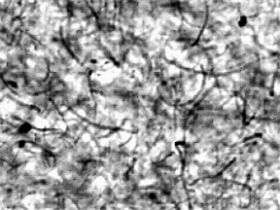Shear Ingenuity: Tweaking the Conductivity of Nanotube Composites

One of the immediate applications of carbon nanotubes (CNT) is as an additive to polymers to create electrically conducting plastics—a relatively low CNT concentration can dramatically change the polymer‘s electrical conductivity by orders of magnitude, from an insulator to a conductor.
New measurements by scientists at the National Institute of Standards and Technology (NIST) have uncovered an intriguing wrinkle. For a given CNT concentration, the electrical properties of the composite can be tuned from being a conductor to a non-conductor simply by changing processing conditions—basically how fast the polymer flows.
Carbon nanotubes—sheets of graphite rolled up into nanoscale hollow cylinders—are under intense scrutiny for a wide range of materials applications. The NIST study shows how the conductivity and dielectric properties of these mixtures depend on flow and how they change once flow has stopped. These property changes have relevance to the process design of these materials in a long list of potential applications for conducting plastics including transparent electrodes, antennas, electronic packaging, sensors, automotive paint, anti-static fuel hoses and aircraft components.
The NIST researchers augmented a standard instrument, a shear rheometer, normally used for viscosity measurements, to simultaneously measure conductivity and dielectric properties Using this “rheo-dielectric spectrometer,” they discovered that the conductivity of the nanocomposite dramatically decreases with increasing flow rate, effectively changing the material from a conductor to an insulator.
This extraordinary sensitivity of the conductivity (and other properties) to flow is prevalent near a characteristic CNT concentration where an interpenetrating CNT network first forms. Surprisingly, once the flow is removed, they found that the nanocomposite reverts back to its original conductivity.
Based on these measurements, the NIST team proposed a theoretical model that successfully accounts for these dramatic effects. This model quantitatively predicts the observed conductor-insulator transition and is useful for optimizing and controlling the properties of these new polymer-nanotube composites.
Citation: J. Obrzut, J.F. Douglas, S.B. Kharchenko and K. B. Migler. Shear-induced conductor-insulator transition in melt-mixed polypropylene-carbon nanotube dispersions. ������Ƶical Review B 76, 195420-2007. Nov. 15, 2007.
Source: NIST





















